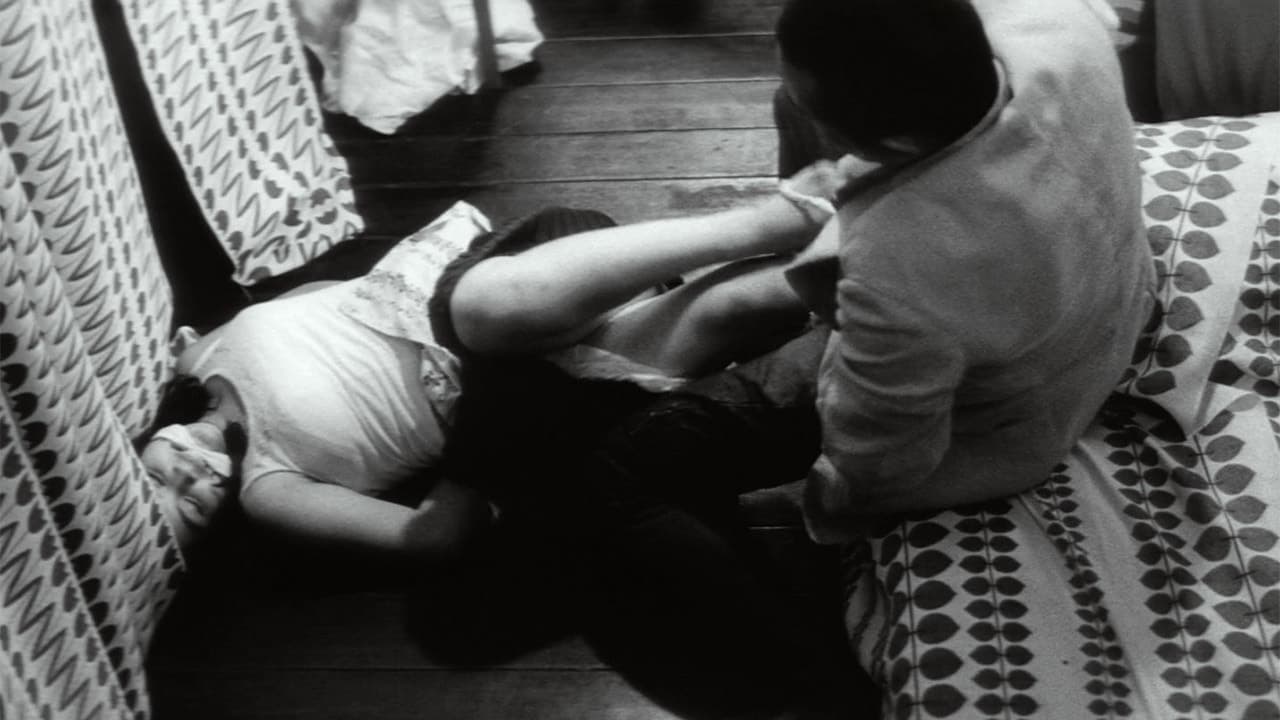

An action-packed slog
... View MoreI really wanted to like this movie. I feel terribly cynical trashing it, and that's why I'm giving it a middling 5. Actually, I'm giving it a 5 because there were some superb performances.
... View MoreThere are moments that feel comical, some horrific, and some downright inspiring but the tonal shifts hardly matter as the end results come to a film that's perfect for this time.
... View MoreBy the time the dramatic fireworks start popping off, each one feels earned.
... View MoreViewed on DVD. Restoration =ten (10) stars; subtitles = four (4) stars; cinematography/lighting = two (2) stars. Director Nagisa Oshima's what-ever-sticks-to-the-wall film experiment sans an exposure meter. A muddled scenario serves mainly as a vehicle for the Director to show off. Most of the photo play consists of truncated (due to Oshima 's use of TV-style close-ups in a wide-screen format) heads incessantly talking about suicide, sex, suicide, and, oh yes, suicide. To break up the monotony, the Director has the camera drift from side to side across the faces of speakers as if they are adrift in a slowly-rocking boat. The lead actor's character comes across more as simple minded rather than as a menacing sex "demon" (or crazed rapist). Lead actresses valiantly try to rise above the banal script despite being saddled with lines consisting of endless variations on themes of suicide (and sex). (Arguably the best line in the script is when a character laments that she has already had two unsuccessful suicides and she is only 20 years old!) While at some level this is meant to be a sex movie, nonetheless Oshima manages to leverage his repetitious direction into viewer disinterest followed by abject boredom-- despite throwing just about "everything" on the let's-shock-the-viewer menu into his mash-up (from hang-'em-high suicides to startling nudity to necrophilia, and on and on). Cinematography (wide screen, black and white) comes across as little better than a home movie with most scenes over or under exposed (the brightness of many exterior scenes may force some viewers to dawn sunglasses to avoid headaches!). Scene-to-scene lighting continuity is close to none existent. Subtitles can be a tad too long and have a tendency to flash by too quickly (the translator would appear to have only a limited familiarity with Kansai-Ben (Western dialog)). The film score is okay, but nothing great. Sound is fine. Recommend skipping this sleep-inducing ego trip! WILLIAM FLANIGAN, PhD.
... View MoreFirst of all, let me correct a wrong statement which you can find in one of the two other reviews on this film: no, Oshima never attended a film school in France, although he was clearly influenced by the French New Wave and eventually shot a film in Paris in the 1980s ("Max my Love"). Now, to see some influence from Resnais' "Marienbad" and "Muriel" in this film is quite right: the lightning-paced editing, jump cuts, elliptical narrative and numerous flashbacks turn this work into a rather challenging one for the viewer, while it presents an interesting reflection on haunted memory (another common point with Resnais).No, as you may guess, this is not a "sit back and relax" film. To put things in a nutshell, "Hakuchu no Torima" is the portrayal of a violent rapist as seen through the recollections of his wife and one of his victims. As the film starts, Eisuke (played by a great Kei Sato) encounters Shino (Saeda Kawaguchi), who works as a maid in a house. She is a former coworker from a failed collective farm, whose life he once saved -- only to rape her. Soon, Eisuke's criminal pattern of rapes and murders emerges as he goes on assaulting women (Shino being the witness of one of them, as Eisuke tries to violate her employer). When cooperating with the police on making a description of the rapist, Shino withholds her crucial knowledge of his identity. She prefers writing letters to Eisuke's dutiful wife, Matsuko, a schoolteacher (Akiko Koyama -- Mrs Oshima), in order to expose his true nature and perhaps induce her into turning Eisuke over to the police. As the police investigation develops, Shino insinuates herself into the investigative process by following Inspector Haraguchi (Fumio Watanabe) as he pursues clues in an attempt to understand Eisuke's destructive impulses. Haraguchi is led to believe that Shino, as Eisuke's first victim, is the underlying cause for his violence. Flashbacks tell us about the complex circumstances behind Eisuke's rescue of Shino at the collective farm, revealing the dual image of Eisuke as both criminal and savior in the eyes of Shino, and explaining the inextricable bond between the criminal and his victim. Strangely enough, Shino and Matsuko will eventually unite their efforts to protect Eisuke from capture... or won't they?Throughout the whole film, Oshima is more preoccupied by the relationship developing between Shino and Matsuko than by the rapist. The despair of both women is linked to that of Eisuke himself and to the failure of the socialist movement in postwar Japan (symbolized by the collapse of the collective farm, after which the true believers either committed suicide or turned to primitively destructive ways). Based on a true story (when Japan was terrorized by a man who raped and killed up to 30 women in 1957-58), shot in a stunning black and white (which makes this film look like no other film from Oshima), "Hakuchu no Torima" explores the themes of guilt and self-destruction, and shows how crime reflects the pathology of the society in which the criminal lives. A difficult yet beautiful and riveting film, for experienced viewers.
... View MoreI bought a rare copy of this for $1 at my local library, being a fan of foreign (especially Japanese) cinema, and never having heard of the director, Nagisa Oshima. I definitely cannot say that the film is bad, because like the reviewer above, I did not understand it. It isn't that I had difficulty following what was happening in the storyline, which was pretty straightforward, but I just had no idea what the intent of the filmmakers were, what the purpose of the story was. The storyline is so bizarre and sensationalistic - a serial rapist and his relationship with both his wife and one of his victims, all three of whom used to be part of some kind of commune for intellectuals (I didn't even know it was a commune until reading another reviewer's synopsis) - that I am sure there must be some underlying symbolism or message here the director was trying to convey. Maybe it had something to do with Japanese society of the time (1966), I'm not sure? Therefore, I must give my opinion of the outward details of the film. The black-and-white cinematography of the film was exquisite, and the constant cutting of shots from scene to scene was highly impressive. It is obvious a great deal of energy and resources were put into the production. This film is outwardly exceedingly beautiful, on a par with other such visual Japanese films as "Kwaidan" and "Kagemusha." The music score was arresting, as well. Other reviewers all seem to compare this to the work of French director Alain Resnais, but I have never seen any of his films. To me, the film seemed distantly related to the works of Stanley Kubrick in its meticulous attention to visual compositions (I saw the film in widescreen, and I can't even imagine watching it in full screen) and its delving into very dark, uncharted psychological territory. Another film to compare this to is Nicholas Roeg's "Bad Timing: A Sensual Obsession" - another dark, non-linear, visually beautiful film whose themes were very difficult to penetrate. The other major drawback is the length - this film does seem to go on about a half hour too long.I would love to have a conversation with the director on just what the storyline means, but unfortunately, I had to watch it without any frame of reference. That made it a frustrating intellectual experience, but an impressive aesthetic one.
... View MorePossibly the most confusing movie I've ever sat through, it took me a long time to get anything out of it. I just couldn't grab onto even the slightest shred of a plot, and, without the ability to find a hook, it felt at first like watching a blank wall. But eventually, I started making inroads and, as the film progresses, its chopped-up plot begins to emerge. It is the story of a rapist and murderer and two women with whom he is intricately involved. Shino is one of his rape victims, and also, we find out, a woman he rescued from suicide in the past. Jinbo is the killer's wife, who knows his guilt (or at least suspects it) but loves him and wants to protect him. Nagisa Oshima actually went to film school in France, and, though part of the Japanese New Wave, no one will miss the French New Wave influences, especially Alain Resnais, whose films have similarly infuriated me in the past with their difficult narratives. Even if I never understood what the hell happened here, the film has several great aspects. The acting is quite good, that's clear. But, in particular, the music, by Hikaru Hayashi, and the cinematography, by Akira Takada, are extremely beautiful. I think I might like this one better if I give it yet another try.ETA: zetes here in the distant year 2010, having just watched the film for the second time. It seems that younger zetes was being a tad dumb, though it could have been the fact that he watched it on a VHS with probably washed-out subtitles (remember those? Yeah, I don't miss them!). The film is actually kind of convoluted, perhaps purposely so. But after the first third of the film, it's fairly clear what's going on. It is quite good, and the visuals and direction are spectacular. This is now available on DVD in an Eclipse box set (it's generally considered to be the best film in that set, too, though I've only watched a couple of films from it so far).
... View More